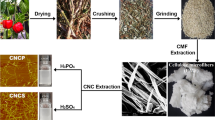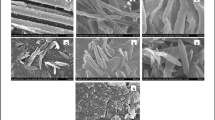Abstract
The present study aimed to convert starch and potato peel waste to nanocrystals. Starch nanocrystals were prepared using two methodologies: direct acid hydrolysis and enzyme pretreatment followed by acid hydrolysis. Direct hydrolysis broke down the starch granules to nanocrystals in 12 days. Enzyme pretreatment with starch hydrolytic enzymes (α-amylase and amyloglucosidase) reduced the time for preparation of starch nanocrystals by 6 days. Starch nanocrystals of optimum size were obtained with both the treatments and the resultant size ranged from 10 to 50 nm. Nanocrystals were disk-like platelets in appearance. Cellulose nanocrystals were derived from cellulosic material in the potato peel. Cellulose was isolated from peel waste with alkali treatment. Further, cellulose nanocrystals from potato peel and cellulose microcrystalline were prepared by acid hydrolysis. Microscopic images revealed that the aqueous suspension of cellulose nanocrystals derived from potato peel were single rod shaped, whereas those derived from cellulose microcrystalline were rod-like nanoparticles, agglomerated in the form of bundles including some of the rods in single units (well separated). The size of potato peel nanocrystals ranged from 40 to 100 nm (length) and cellulose microcrystalline ranged from 4 to 20 nm (diameter) by 110 to 250, given 4 to 20 nm (length), respectively. As starch nanocrystals as well as cellulose nanocrystals are derived from biopolymer, both can be considered safe for humans and the environment. Moreover, the biodegradable nature of these nanocrystals makes them superior over metallic nanoparticles, particularly in the field of nanocomposites.





Similar content being viewed by others
References
Averous L, Halley PJ (2009) Biocomposites based on plasticized starch. Biofuels Bioprod Biorefin 3(3):329–343
Beck-Candanedo S, Roman M, Gray DG (2005) Effect of reaction conditions on the properties and behavior of wood cellulose nanocrystal suspensions. Biomacromolecules 6:1048–1054
Bica CID, Borsali R, Rochas C, Geissler E (2006) Dynamics of cellulose whiskers spatially trapped in agarose hydrogels. Macromolecules 39:3622–3627
Cao X, Dong H, Li CM (2007) New nanocomposite materials reinforced with flax cellulose nanocrystals in waterborne polyurethane. Biomacromolecules 8(3):899–904
Chen G, Wei M, Chen J, Huang J, Dufresne A, Chang PR (2008) Simultaneous reinforcing and toughening: new nanocomposites of waterborne polyurethane filled with low loading level of starch nanocrystals. Polymer 49(7):1860–1870
Chen Y, Liu C, Chang PR, Cao X, Anderson DP (2009) Bionanocomposites based on pea starch and cellulose nanowhiskers hydrolysed from pea hull fibre: effect of hydrolysis time. Carbohydr Polym 76:607–615
Chen D, Lawton D, Thompson MR, Liu Q (2012) Biocomposites reinforced with cellulose nanocrystals derived from potato peel waste. Carbohydr Polym 90:709–716
Dufresne A (2010) Natural rubber green nanocomposites. In: Ranimol S, Thomas S (eds) Rubber nanocomposites: preparation, properties, and applications. John Wiley & Sons, Singapore, pp 113–145
Fuglie KO (1999) Raw materials for starch in Asia: some economic considerations. UPWARD [Users’ perspective with agricultural Research and Development network] field Notes,7(2): 5–7
Hafraoui S, Nishiyama Y, Putaux J-L, Heux L, Dubreuil F, Rochas C (2008) The shape and size distribution of crystalline nanoparticles prepared by acid hydrolysis of native cellulose. Biomacromolecules 9:57–65
Kim J-Y, Park D-J, Lim S-T (2008) Fragmentation of waxy rice starch granules by enzymatic hydrolysis. Cereal Chem 85(2):182–187
Lani NS, Ngadi N, Johari A, Jusoh M (2014) Isolation, characterization and application of nanocellulose from oil palm empty fruit bunch fiber as nanocomposites. J Nanomater., Article ID 702538, 9 pages. https://doi.org/10.1155/2014/702538
LeCorre D, Bras J, Dufense A (2012a) Influence of native starch’s properties on starch nanocrystals thermal properties. Carbohydr Polym 87:658–666
LeCorre D, Vahanian E, Dufresne A, Bras J (2012b) Enzymatic pretreatment for preparing starch nanocrystals. Biomacromolecules 13:132–137
Li Y, Ragauskas AJ (2011) Cellulose nano whiskers as reinforcing filler in polyurethanes. In: Reddy B (ed.). Advances in diverse industrial applications of nanocomposites, ISBN: 978–953–307-202-9. pp 17–36
Lin N, Huang J, Chang PR, Feng L, Yu J (2011) Effect of polysaccharide nanocrystals on structure, properties, and drug release kinetics of alginate-based microspheres. Colloids Surf B: Biointerfaces 85(2):270–279
Lin N, Huang J, Dufresne A (2012) Preparation, properties and applications of polysaccharide nanocrystals in advanced functional nanomaterials: a review. Nano 4:3274–3294
Morais JPS, de F Rosa MF, Filho M d s M d S, Nascimento LD, Nascimento DM, Cassales AR (2013) Extraction and characterization of nanocellulose structures from raw cotton linter. Carbohydr Polym 91:229–235
Othman SH, Rashid SA, Ghazi TI, Abdullah N (2012) Dispersion and stabilization of photocatalytic TiO2 nanoparticles in aqueous suspension for coating applications. J Nanomater. https://doi.org/10.1155/2012/718214, Article ID 718214, 10 pages
Pelissari FM, Sobral PJA, Menegalli FC (2014) Isolation and characterization of cellulose nanofibers from banana peels. Cellulose 21:417–432
Qua EH, Hornsby PR, Sharma HSS, Lyons G, McCall RD (2009) Preparation and characterization of poly(vinyl alcohol) nanocomposites made from cellulose nanofibers. J Appl Polym Sci 113(4):2238–2247. https://doi.org/10.1002/app.30116
Raigond P, Ezekiel R, Kaundal B (2014) Starch fractions of cooked potatoes at low temperature. Potato J 41(1):58–67
Raigond P, Ezekiel R, Singh B, Dutt S, Joshi A and Rinki (2015) Resistant starch production technologies—a review. Potato J 42(2): 81–94
Raigond P, Raigond B, Kaundal B, Singh B, Joshi A, Dutt S (2017) Effect of zinc nanoparticles on antioxidative system of potato plants. J Env Biol 38:435–439
Rajisha KR, Maria HJ, Pothan LA, Ahmad Z, Thomas S (2014) Preparation and characterization of potato starch nanocrystal reinforced natural rubber nanocomposites. Int J Biol Macromol 67:147–153
Rosa MF, Medeiros EF, Malmonge JA, Gregorsky KS, Wood DF, Mattoso LHC et al (2010) Cellulose nanowhiskers from coconut husk fibers: effect of preparation conditions on their thermal and morphological behavior. Carbohydr Polym 81(1):83–92
Rosa SML, Rehman N, de Miranda MIG, Nachtigall SMB, Bica CID (2012) Chlorine-free extraction of cellulose from rice husk and whisker isolation. Carbohydr Polym 87:1131–1138
Samir M, Alloin F, Dufresne A (2005) Review of recent research into cellulosic whiskers, their properties and their application in nanocomposite field. Biomacromolecules 6(2):612–626
Singh B, Mehta A, Raigond P (2014) Management practices to reduce the post harvest losses in potatoes. In: Souvenir of national seminar on ‘post harvest management and processing of potatoes for increasing food security in India’. pp: 1–5
Singh B, Raigond P, Joshi A, Mehta A, Singh BP (2016) A manual on potato processing in India. CPRI Technical Bulletin No. 48 (Revised). ICAR- Central Potato Research Institute, Shimla, pp 1
Valodkar M, Thakore S (2011) Isocyanate crosslinked reactive starch nanoparticles for thermo-responsive conducting applications. Carbohydr Res 345(16):2354–2360
Wu Y, Xianfeng D, Ge H, Lv Z (2011) Preparation of microporous starch by glucoamylase and ultrasound. Starch 63:217–225
Zhang X, Huang J, Chang PR, Li J, Chen Y, Wang D, Yu J, Chen J (2010) Structure and properties of polysaccharide nanocrystal-doped supramolecular hydrogels based on cyclodextrin inclusion. Polymer 51(19):4398–4407
Acknowledgements
Authors are thankful to Indian Council of Agriculture Research (ICAR), New Delhi for its support by sanctioning a project titled “Biodegradable and antimicrobial nanocomposite films based on potato starch for food packaging application” through Consortium Research Platform (CRP) on Nanotechnology.
Author information
Authors and Affiliations
Corresponding author
Ethics declarations
Conflict of Interest
The authors declare that they have no conflict of interest.
Human and Animal Rights and Informed Consent
This article does not contain any studies with human or animal subjects.
Rights and permissions
About this article
Cite this article
Raigond, P., Raigond, B., Kochhar, T. et al. Conversion of Potato Starch and Peel Waste to High Value Nanocrystals. Potato Res. 61, 341–351 (2018). https://doi.org/10.1007/s11540-018-9381-4
Received:
Accepted:
Published:
Issue Date:
DOI: https://doi.org/10.1007/s11540-018-9381-4




